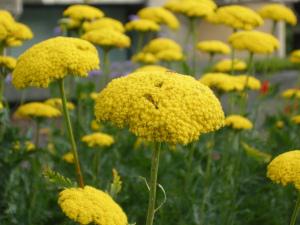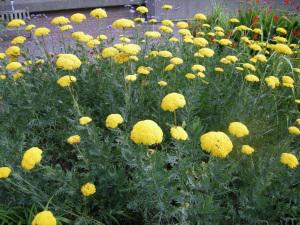
Achillea filipendulina flower (25/07/2011, London)
Position: Full sun
Soil: Well drained soil
Flowering period: Summer to autumn
Eventual Height: 1.5m
Eventual Spread: 1m
Hardiness: USDA Zone 3a-10b
Family: Asteraceae
Achillea filipendulina is a deciduous perennial with an upright habit. Its fern-like foliage has a rough, hairy texture and is linear, pinnate and lobed with a serrate margin. Its inflorescence is in the form of a terminal cluster of corymbs composed of small yellow hermaphroditic flowers.
A. filipendulina, commonly known as Fernleaf Yarrow, is native to Caucacus region including Chechnya, Dagestan, North Ossetia, South Ossetia, Georgia and Azerbaijan.
Achillea is named for a character in Greek mythology; Achilles, the almost invulnerable warrior whose soldiers were said to use the plant to treat wounds. Filipendulina is a Latinised word meaning that the plant has foliage similar to members of the Filipendula genus.

Achillea filipendulina (25/07/2011, London)
The landscape architect may find this plant useful as a robust medium height herbaceous perennial which provides bright summer/ autumn flowers. It is also very appropriate in informal prairie schemes. It is drought tolerant once established.
The Royal Horticultural Society gave the cultivars Achillea filipendulina ‘Cloth of Gold’ and ‘Parker’s Variety’ their prestigious Award of Garden Merit in 1999 with the ‘Gold Plate’ cultivar having its status reconfirmed in 1999 after first gaining the award in 1993 .
This plant will tolerate almost any soil conditions; it will be happy at neutral, alkaline or acid pH levels, in loam, sand, chalk or clay based soils in any south, east or west facing exposed aspect.
Ecologically this plant will attract many species of pollinating insects such as honey bees and butterflies and certain species of birds will also use it to line their nests.
Maintenance: This plant requires little to no maintenance. Untidy foliage may be cut back in spring. A. filipendulina may be propogated by division in spring.

